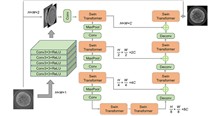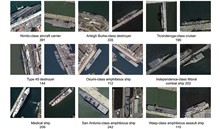
Synchrotron radiation-based full-field nano-computed tomography (CT) is capable of non-destructive detection of the internal 3D structure of samples with nanoscale spatial resolution, and has a wide range of applications. Conventional nano-CT requires the acquisition of numerous projection images to ensure the accuracy and high resolution of 3D reconstruction, which is not only time-consuming but also may cause radiation damage to the sample. In this study, a novel denoising network model, SwinCBD (Swin Transformer-based convolutional blind denoising), is proposed to address the challenges of nano-CT technology. The SwinCBD model is based on Swin Transformer and convolutional neural network to establish structural relation mapping between noisy images and clean images through deep learning to achieve high-quality reconstruction of low-dose nano-CT with low exposure and fewer projections. The experimental results show that the low-dose nano-CT image denoising based on the SwinCBD model improves the signal-to-noise ratio of the low-dose CT slice images (by 49.26%), and drastically reduces the nano-CT projections acquisition time under the premise of ensuring the image quality. The model will be important for improving the nano-CT temporal resolution and reducing the radiation damage of samples.
With the advancement of phased fiber laser array technology toward more units, pointing errors between array beams have become a critical factor affecting beam combining performance. To address the challenges in fabricating light-intensity gradient trap modulation plates for beam pointing control based on light-intensity gradient traps, this paper proposes and employs a lithographic mask process to fabricate a light-intensity gradient trap modulation plate with annular stripe patterns. The measured light intensity transmittance aligns with the design value, and the root mean square error (RMSE) of the normalized transmittance is 0.0166. Through simulations and experiments, rapid correction of beam pointing errors in an extended area was achieved using the stochastic parallel gradient descent algorithm and an adaptive fiber-optics collimator. With an initial average beam pointing error of approximately 702 μrad, the mean residual pointing error after correction was reduced to less than 10 μrad. This research provides important references for laser pointing control and beam combining on extended targets.
In the current fine-grained classification task of ships, approaches that rely solely on single image data can only classify by extracting the image features of the target. However, they struggle to capture the complex relationships between the ship's main body and its components, thereby limiting recognition accuracy and results in poor generalization. A data- and knowledge-driven fine-grained classification method, termed DKSCN, is proposed for ships. The object detection network is utilized to detect the ship's main body and its key parts. By designing a graph convolutional network and integrating expert knowledge, a semantic knowledge graph is established to capture the relationships between the ship's main body and its key components. During classification, domain knowledge is incorporated to guide the data-driven process. Comparative experimental results on a self-constructed dataset demonstrate that this method not only addresses the limitations of single data-driven models but also improves classification accuracy.
This study addresses the limitations of existing endoscopic optical coherence tomography (OCT) probes in field of view (FOV), resolution, and dimensions constraints by proposing a novel design for a large-FOV forward-scanning endoscopic probe. The probe employs an optical system comprising six spherical lenses with an outer diameter of 1.4 mm, integrated with piezoelectric ceramic-driven fiber scanning technology. Operating in the 1000-1100 nm wavelength range, it achieves a scanning FOV of 6.0 mm, a lateral resolution of 24 μm, and an axial resolution of 20 μm, while maintaining a compact mechanical outer diameter of merely 1.6 mm. A swept-source OCT system was developed to validate the probe’s performance through imaging experiments on ex vivo porcine eyes. Results demonstrate the probe’s capability to clearly distinguish iris, sclera, and retinal structures, as well as visualize retinal detachment phenomena. Comparative analyses with graded-index lens probes reveal superior FOV expansion and reduced imaging artifacts. The study confirms that this probe effectively integrates miniaturization, high-resolution imaging, and large-FOV advantages, providing a new solution for ophthalmic minimally invasive surgical navigation. Future research could focus on further reducing the outer diameter and integrating two-dimensional scanning functionality to enhance its clinical potential.
3D multi-object tracking technology can help unmanned vehicles accurately perceive their surroundings, identify objects such as pedestrians and vehicles, and predict their movement trajectories, which is important for improving the safety of unmanned systems and reducing traffic accidents. In order to improve the performance of 3D multi-object tracking, a detection-based 3D multi-object tracking framework is proposed, which generates a 3D bounding box with identity, position, and shape in real time from the point cloud provided in each successive frame. Specifically and firstly, to address the shortcomings of traditional IoU, an efficient adaptive conversion intersection and merger ratio (AC-IoU) method is proposed to optimize the data metric between prediction and actual detection. Secondly, in order to increase the number of successful matches and enhance the accuracy of the trajectory, a cascade matching method combining spatial correlation and geometric features is proposed, where the first stage is responsible for matching objects with high confidence, and the second stage focuses on handling objects that are difficult to correlate due to occlusion, low confidence, or other complex situations. Experimental results on the KITTI dataset show that the tracking accuracy is improved by 0.79%, the tracking precision is improved by 3.67%, and the frame rate has reached 115 f/s. These results prove the efficiency and reliability of this paper's method in the task of tracking objects such as pedestrians and cars.
A femtosecond laser with a wavelength of 515 nm is used to perform polishing operations on the surface of titanium metal to analyze the formation mechanism of surface morphology in the processed area under different laser parameters. By changing the laser focus position to suppress the formation of a hump-like structure, the processing quality is significantly improved and the optimal laser parameter window for polished titanium metal is obtained. It is found that when the laser focus is on the surface of the sample, the size of the bump-like structure increases with the increment of the number of processed layers and gradually spreads from the scratch of the sample to the whole processed area. At an energy density of 25.88 J/cm2, the positive defocus amount gradually increases in the range from 0 to 2.5 mm, and then the hump-like structure gradually decreases until it disappears completely, while the polishing depth increases from 38.94 μm to 108.02 μm. The surface roughness is reduced from the original 1.496 μm to 0.314 μm when the defocus amount is 2.5 mm.
A simulation system is an efficient tool in laser remote sensing research, effectively advancing system construction and algorithm validation, thereby enhancing research efficiency. To meet the demands of direct scattering spectrum LiDAR for marine remote sensing applications, a comprehensive marine multi-environmental element measurement simulation system was established based on Qt. This system encompasses the laser emission system, seawater channel system, optical reception and spectral measurement system, and signal processing system, achieving full-process simulation. Several simulations were conducted using this system, including system integrity verification and reliability analysis experiments. The simulation results were compared with actual measurement data, showing high consistency and verifying the reliability of the simulation system. The system provides valuable guidance for LiDAR marine remote sensing experiments.
Hydrogen, as a clean energy source, plays a crucial role in fuel cells and industrial applications. However, its flammability makes the development of real-time, sensitive, and safe hydrogen detection technologies a key factor for expanding its applications. Traditional palladium (Pd)-based thin film sensors, due to their dense structure, have a relatively slow hydrogen diffusion rate and a long response time. To address this issue, this paper proposes the design of a hydrogen optical sensor based on a palladium nanoparticle superlattice thin film, which can be prepared by a self-assembly method to reduce costs. Compared with the traditional dense thin film system, the specific surface area of this palladium nanoparticle thin film can be as high as 1.2×107 cm?1, which is conducive to the rapid diffusion of hydrogen and is expected to improve the sensing response rate. In addition, the calculation results show that when hydrogen diffuses into the interior of palladium to form PdHx, as the atomic ratio (x) of H/Pd increases from 0 to 1, the change in the transmittance intensity of the palladium nanoparticle superlattice thin film reaches 38%, which is significantly greater than that of the traditional dense thin film system, indicating higher sensitivity. This study provides a theoretical basis for the development of real-time and highly sensitive hydrogen sensors.
The deformation distribution of engineering structures can evaluate the health status of the bridge structures, but the traditional "point based" sensing technology has significant shortcomings in obtaining the overall structural deformation distribution. This article proposes a curvature identification deflection curve method suitable for monitoring the deformation distribution of simply supported steel box girder structure based on quasi distributed fiber Bragg grating strain measurement technology. Theoretical exploration of the principle of strain curvature deflection curve inversion for fiber Bragg gratings. Numerical simulations of four point bending tests on simply supported box girders show that the method based on curvature identification of deflection has high accuracy, and the relative error at the mid span is only 2.14%. The fiber optic grating strain sensor encapsulated in a stainless steel tube was arranged on the surface of a simply supported steel box girder with a span of 2 meters, and a good linear correlation was obtained between the structural deformation distribution and strain distribution. The maximum relative error between the inverted deflection and the dial gauge at the mid span was less than 3.80%, providing a reference scheme for the long-term deformation monitoring of box girders with distributed distribution.
To address the issues of significant sample imbalance among different quality levels and low grading efficiency in retinal image quality grading tasks, this paper proposes a multi-frequency Transformer-guided graph-based feature aggregation method for retinal image quality grading. First, contrast-limited adaptive histogram equalization (CLAHE) is applied to enhance key details in the images. Then, a ResNet50 network is employed for multi-level feature extraction. Next, a frequency-channel transformer module is designed, which incorporates frequency-domain information to assist in global feature modeling, thereby optimizing the balance between international and local features. Subsequently, a graph cross-feature aggregation module is introduced, leveraging a cross-scale cross-attention mechanism to guide image aggregation, aligning multi-source features, and enhancing the model’s sensitivity to multi-level features. Finally, a weighted loss function increases the model’s attention to minority-class samples. Experiments conducted on the Eye-Quality and RIQA-RFMiD datasets achieved accuracy rates of 88.71% and 84.95%, with precision rates of 87.78% and 74.22%, respectively. The experimental results demonstrate that the proposed algorithm holds significant application value in retinal image quality assessment.














